Warehouse Pallet Storage Racks: The Complete 2025 Guide to Space Optimization and Efficiency
Classification:
Industry Info
Release time:
2025-08-20
What Are Warehouse Pallet Storage Racks?
Warehouse pallet storage racks are structured shelving systems designed to hold palletized goods in vertical tiers. They allow forklifts or automated systems to store and retrieve pallets efficiently, reducing wasted floor space and improving organization.
Main Types of Warehouse Pallet Storage Racks
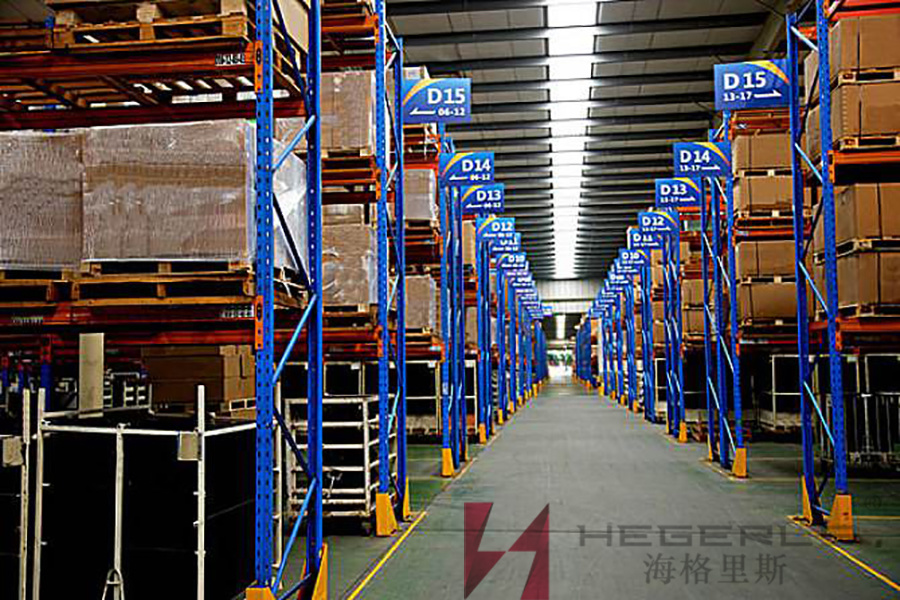
Selective Pallet Racks(Most Common and Versatile)
Selective pallet racking is the most widely used system because it offers direct access to every pallet at all times. This makes it ideal for warehouses that store a wide variety of products with different SKUs.
Key Features:
Single- or double-deep configurations
Adjustable beam heights for flexibility
Compatible with most forklift types
Best For:
Warehouses with many SKUs and moderate turnover rates
E-commerce fulfillment centers
Distribution hubs
Pros:
High selectivity
Easy to install and reconfigure
Cost-effective
Cons:
Lower storage density compared to high-density systems
Drive-In and Drive-Through Pallet Racks (High-Density Storage)
These racks are designed for maximum space utilization by allowing forklifts to enter the rack structure to load and unload pallets.
Drive-In Racks have a single entry and exit point (LIFO – Last In, First Out), while Drive-Through Racks allow forklifts to enter from both sides (FIFO – First In, First Out).
Key Features:
Store large volumes of similar products
Rails guide the pallets into position
Eliminates multiple aisles for space savings
Best For:
Cold storage facilities
Seasonal product storage
Bulk inventory of identical SKUs
Pros:
Up to 85% space utilization
Reduces need for wide aisles
Cons:
Limited selectivity
Slower access to individual pallets
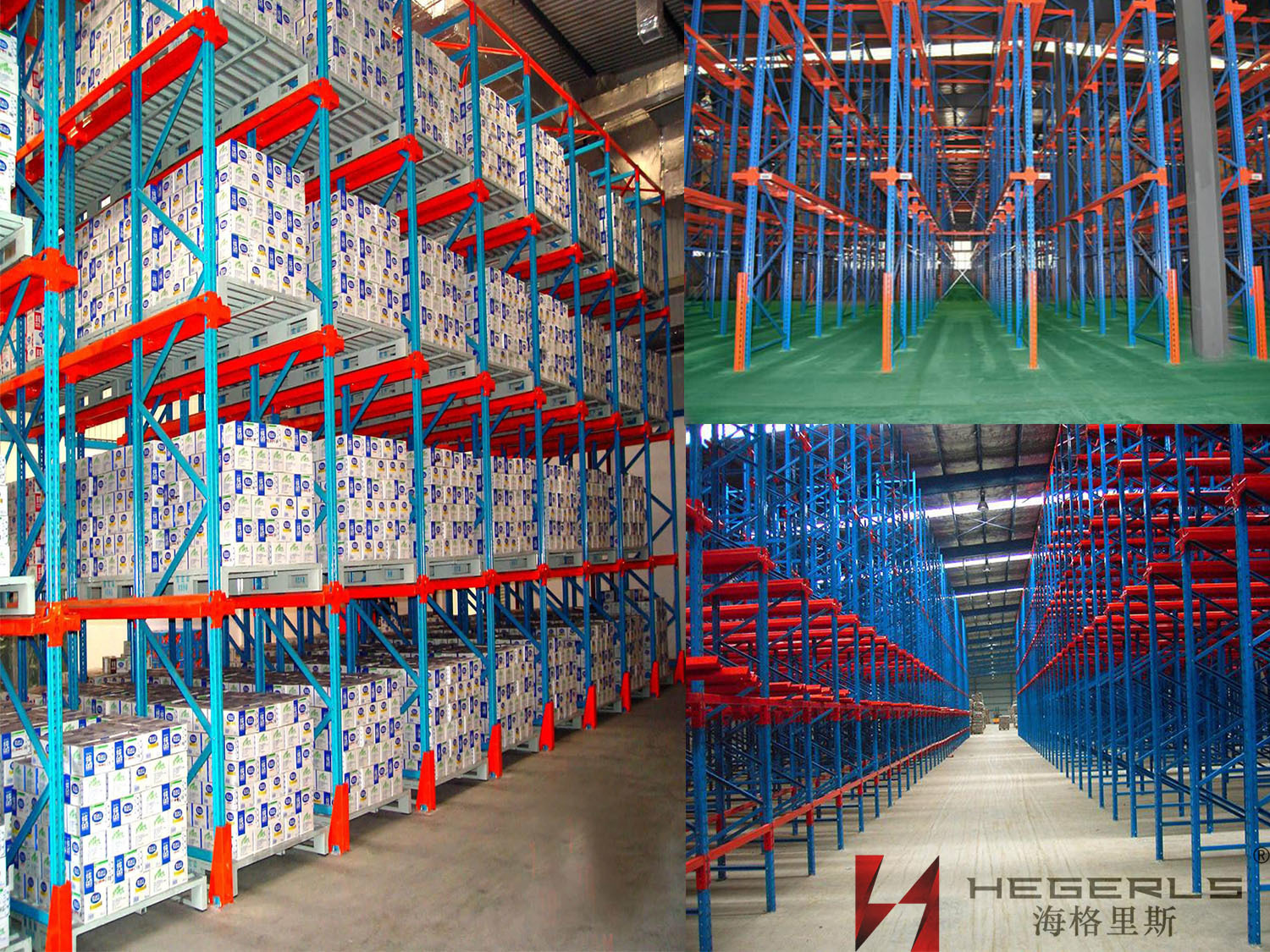
Push-Back Pallet Racks (High Density + Good Selectivity)
Push-back racks store pallets on nested carts that move along inclined rails. When a pallet is removed, the next one rolls forward automatically.
Key Features:
LIFO inventory management
Can store 2–6 pallets deep per lane
Ideal for medium-turnover products
Best For:
Warehouses balancing storage density with faster picking
Food and beverage distribution (non-perishable)
Consumer goods warehouses
Pros:
Higher density than selective racks
Reduced forklift travel time
Cons:
Slightly more expensive than selective racks
Pallet Flow Racks (FIFO & High Rotation)
Pallet flow racks use gravity rollers to move pallets from the loading side to the picking side automatically. Perfect for First In, First Out inventory systems.
Key Features:
Continuous product rotation
Ideal for perishable goods
Minimal forklift interference in picking zones
Best For:
Cold storage (dairy, frozen foods)
Beverage bottling plants
Pharmaceutical warehouses
Pros:
Excellent stock rotation
High-density storage
Cons:
Higher installation cost
Requires good pallet quality for smooth flow
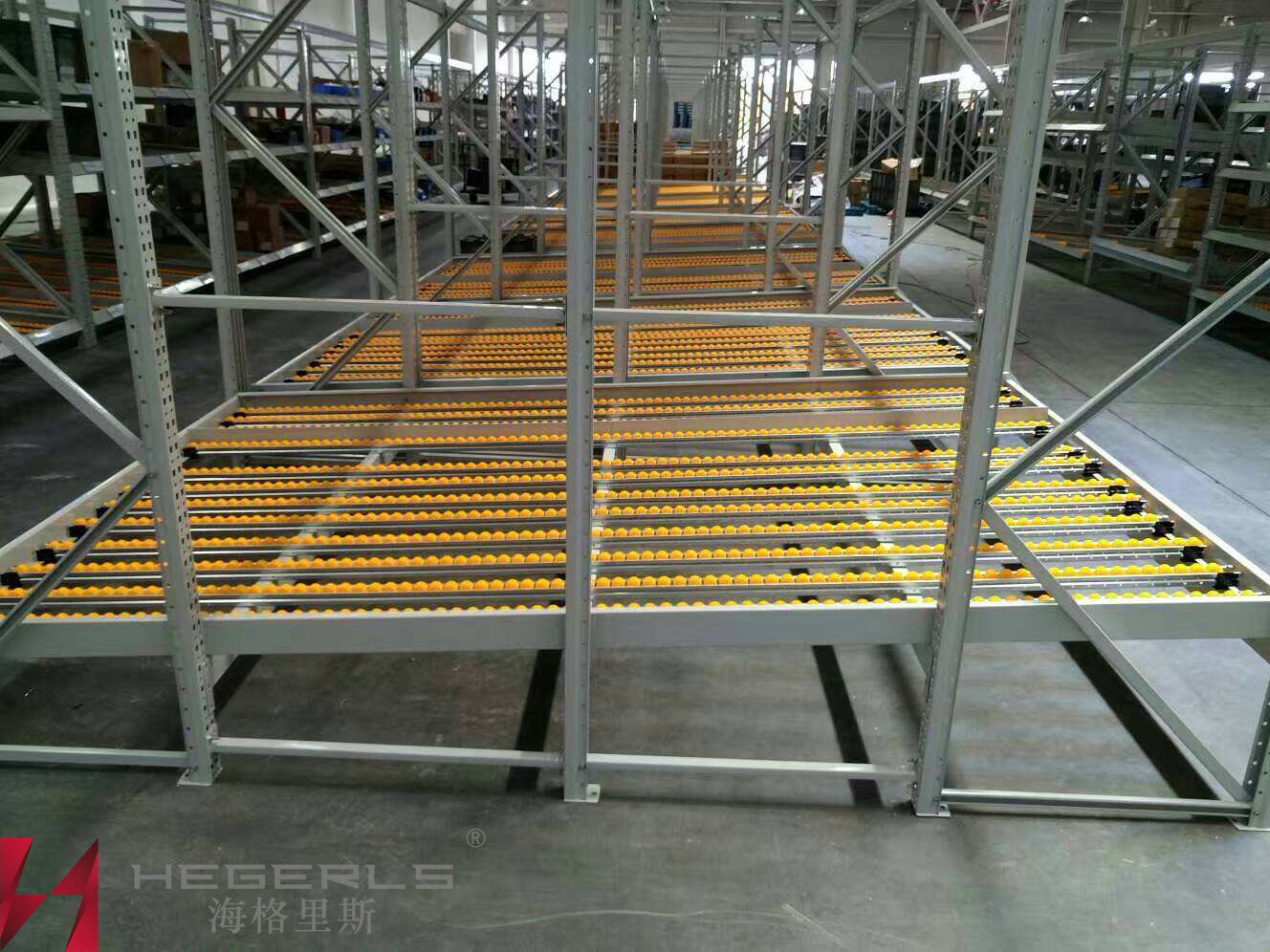
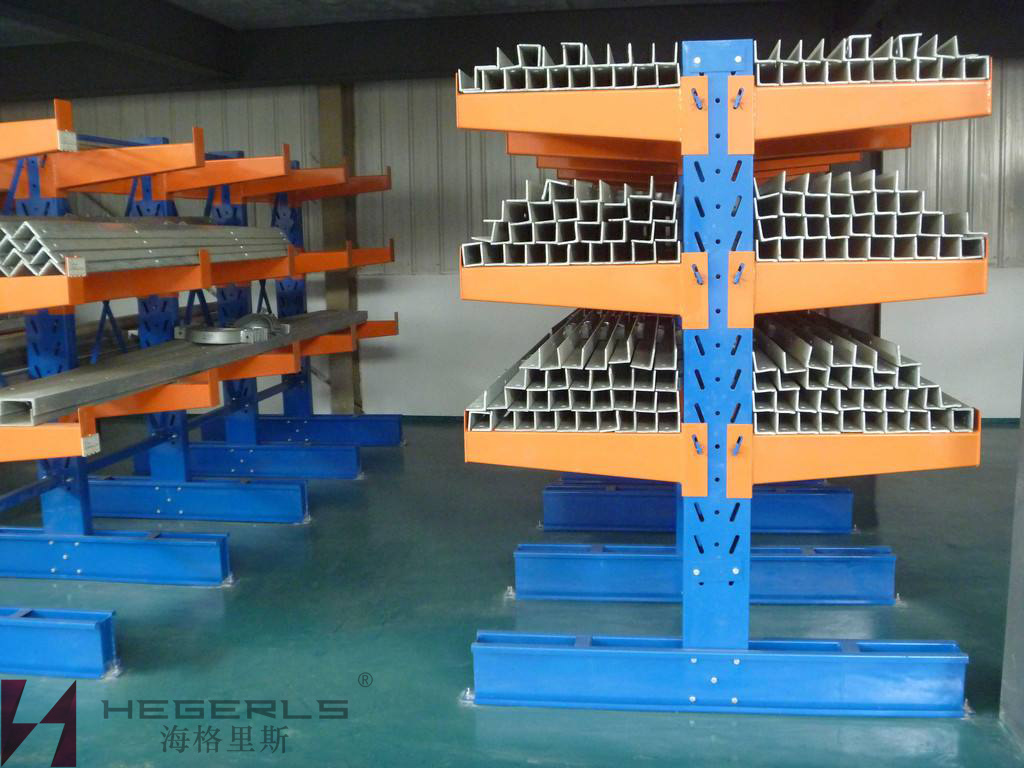
Cantilever Racks (For Long or Irregular Items)
Cantilever racks are designed without front columns, allowing unobstructed storage of long, bulky, or awkwardly shaped items.
Key Features:
Arms extend from vertical columns to support loads
Can be single-sided or double-sided
Easy loading with forklifts or cranes
Best For:
Lumber, metal bars, steel sheets, PVC pipes
Furniture storage
Construction material warehouses
Pros:
Flexible storage for non-palletized goods
Open-front design for easy handling
Cons:
Not ideal for standard pallet storage
Double-Deep Pallet Racks (Maximized Density Without Full Drive-In)
This is a variation of selective racking where pallets are stored two deep, requiring a special deep-reach forklift.
Key Features:
Higher density than single-deep selective racks
LIFO storage method
Reduced number of aisles
Best For:
Medium- to high-turnover inventory
Large warehouses with specialized forklifts
Pros:
Increased storage capacity
Lower cost than push-back or drive-in
Cons:
Reduced selectivity compared to single-deep racks
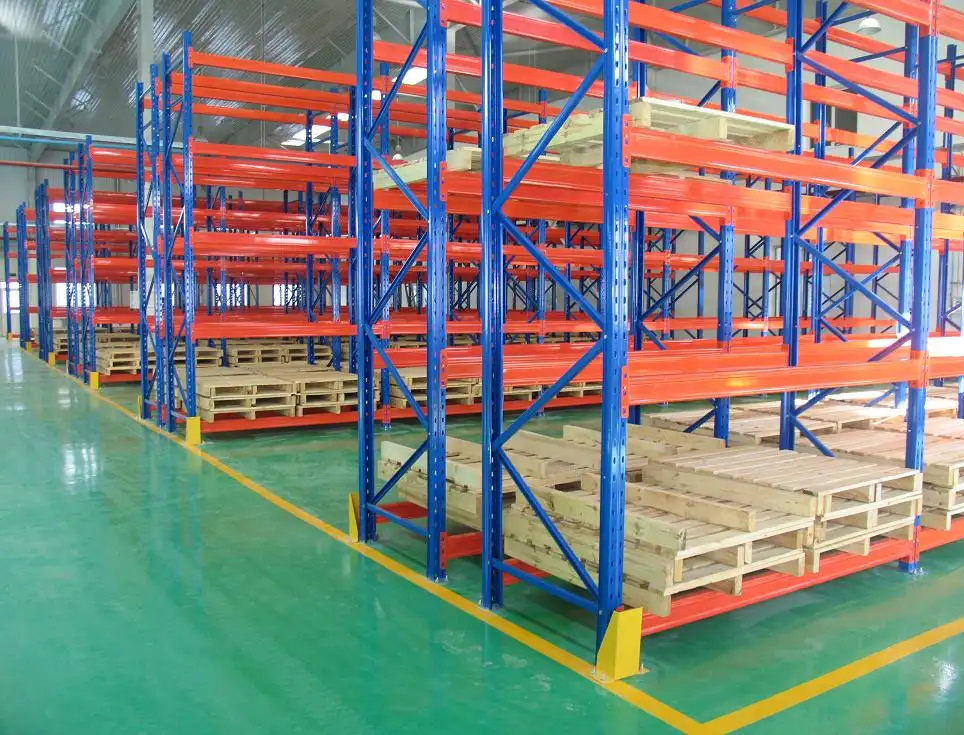
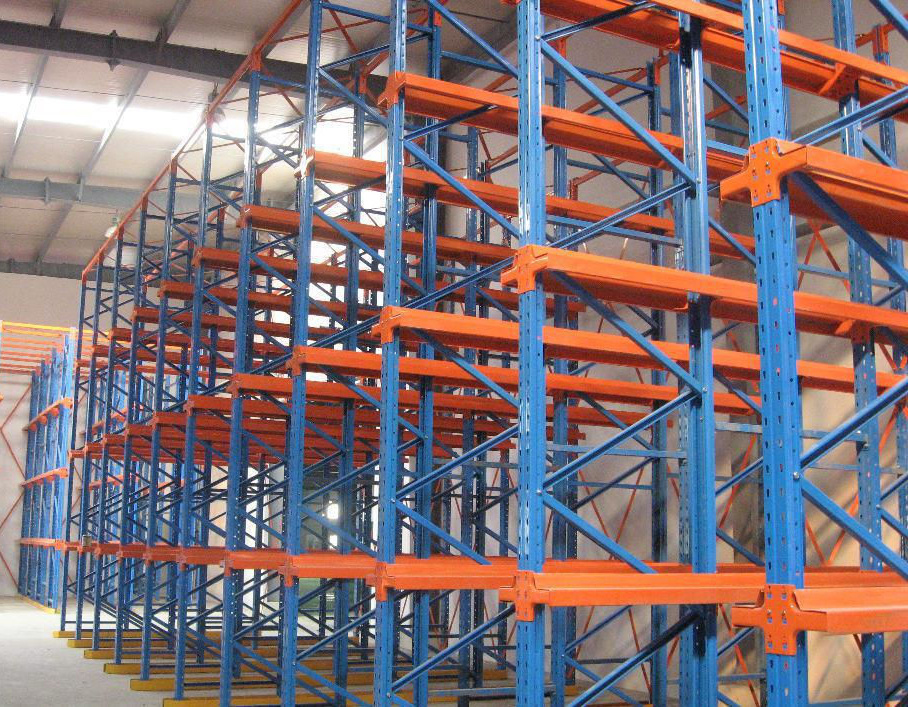
Mobile Pallet Racking Systems (Space-Saving Automation)
Mobile racking systems are mounted on motorized bases that move along floor tracks, eliminating unnecessary aisles. Operators open only the aisle they need to access.
Key Features:
Up to 90% space utilization
Remote or automated control
Safety sensors for operation
Best For:
High-value inventory
Cold storage where space is expensive
Archives or slow-moving goods
Pros:
Extremely high density
Flexible access with reduced footprint
Cons:
Higher investment cost
Slightly slower access time
Mezzanine Racking Systems (Vertical Expansion)
Mezzanine racks create a second or even third level of storage within the warehouse. Pallet racks form the support for upper-level flooring.
Key Features:
Increases usable floor space without building expansion
Can combine shelving, racking, and office space
Accessible via stairs, lifts, or conveyors
Best For:
Warehouses with high ceilings
Mixed storage (pallets + small parts)
Order fulfillment centers
Pros:
Maximizes cubic space
Adds workspace or storage capacity
Cons:
Requires structural engineering approval
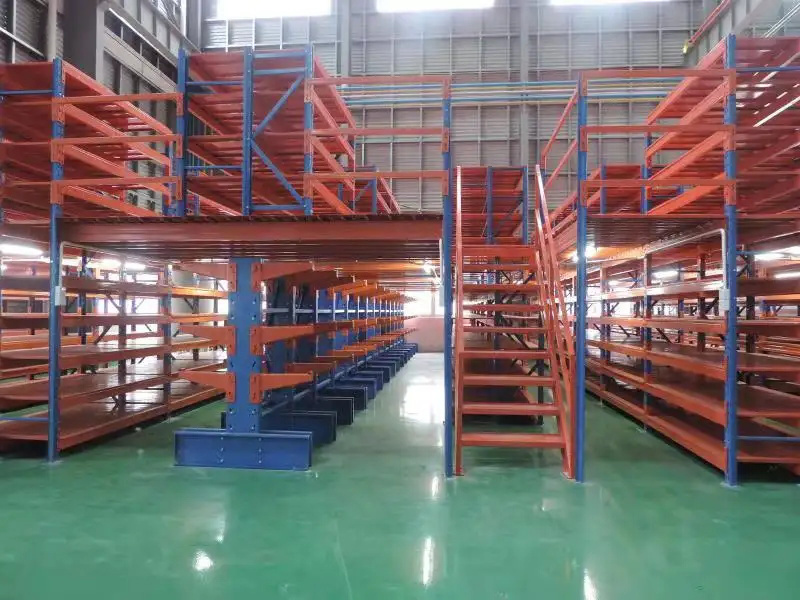
Benefits of Warehouse Pallet Storage Racks
1. Maximizes Warehouse Space Utilization
Pallet racks use vertical height instead of only floor space, enabling warehouses to store more products without expanding their footprint. This is especially valuable where land and rental costs are high.
2. Improves Inventory Organization and Accessibility
By categorizing products across multiple rack levels, pallet racking makes inventory easy to locate and access. Forklifts can retrieve goods efficiently, reducing time wasted in searching or handling.
3. Enhances Storage Density
Depending on the racking type (selective, drive-in, push-back, mobile, or shuttle), businesses can optimize between storage density and selectivity, achieving the best balance for their operations.
4. Increases Productivity
With goods systematically arranged and easily retrievable, order picking and replenishment become faster. This reduces downtime and boosts warehouse throughput.
5. Improves Safety
High-quality pallet racks are designed with stability, load-bearing capacity, and anti-fall accessories. This minimizes the risk of accidents, protecting both workers and stored goods.
6. Scalability and Flexibility
Pallet rack systems can be expanded, reconfigured, or combined with automation (shuttle systems, stacker cranes, or AS/RS) to meet growing business needs.
7. Cost-Effective Investment
By maximizing warehouse capacity without requiring new buildings or larger facilities, pallet racking reduces operational costs and delivers long-term ROI.
8. Supports FIFO and LIFO Inventory Management
Different racking systems (such as drive-in, push-back, or pallet flow racks) can be tailored to support FIFO (first in, first out) or LIFO (last in, first out) strategies, ensuring better inventory rotation.
9. Enhances Warehouse Aesthetics and Professionalism
A well-structured racking system creates a clean, organized, and professional warehouse environment, which helps with safety audits and impresses clients during inspections.
10. Compatible with Automation and Modern Logistics
Modern pallet racks can integrate seamlessly with automated guided vehicles (AGVs), shuttles, conveyors, and warehouse management systems (WMS), future-proofing warehouse operations.
How to Choose the Right Pallet Racking System
1. Assess Your Storage Needs
- Product type & size: Are you storing standard pallets, irregular goods, or oversized items?
- Load capacity: Calculate the weight per pallet and per rack level to ensure structural safety.
- Storage density: Decide whether you need high selectivity (easy access to each SKU) or high density (maximize space for bulk storage).
2. Consider Warehouse Layout & Space Utilization
- Ceiling height: Higher ceilings allow for taller racking systems.
- Aisle width: Narrow aisles can fit more racks but require specialized forklifts.
- Building structure: Columns, fire sprinklers, and doors influence rack design and placement.
3. Choose the Right Racking Type
Different racking systems suit different operations:
- Selective Pallet Racking – Best for high SKU variety and easy access (FIFO).
- Drive-In/Drive-Through Racking – Ideal for bulk storage with low SKU variety (LIFO).
- Push-Back Racking – Medium selectivity and density, supporting LIFO.
- Pallet Flow Racking – Perfect for FIFO and perishable goods (gravity-fed).
- Cantilever Racking – For long, irregular, or oversized items.
- Mobile Racking Systems – Space-saving, high-density storage with only one working aisle.
- Automated Shuttle or AS/RS Systems – For large-scale, high-efficiency warehouses.
4. Forklift & Equipment Compatibility
Your choice of racking must align with handling equipment:
- Standard forklifts → wider aisles and selective racks.
- Reach trucks or narrow-aisle forklifts → allow narrower aisles, higher density.
- Automated systems (AGVs, stacker cranes, shuttles) → require precise rack compatibility.
5. Future Growth & Scalability
Choose a system that can expand or be reconfigured as your business grows.
Modular racking systems and automation-ready solutions help future-proof your warehouse.
6. Safety & Compliance
Ensure racks meet international standards (e.g., RMI, FEM, CE).
Add safety accessories: rack protectors, load signs, anti-fall mesh, and guard rails.
Regular inspections and maintenance are essential for safe operation.
7. Budget & ROI
Balance initial investment with long-term efficiency gains.
Consider the cost of land/warehouse expansion vs. installing a high-density racking system.
ROI comes not only from storage capacity but also from faster operations and reduced labor.
Trends in Pallet Racking for 2025 and Beyond
1. Integration with Automation and Robotics
Pallet racking systems are increasingly designed to work with automated guided vehicles (AGVs), shuttles, stacker cranes, and robotic picking arms.
Automated Storage and Retrieval Systems (AS/RS) are becoming mainstream for high-throughput warehouses.
This integration reduces labor dependency, speeds up operations, and supports 24/7 fulfillment.
2. Smart Racking with IoT and Sensors
Embedded sensors, RFID, and IoT technology are transforming racks into intelligent storage systems.
Real-time monitoring tracks pallet locations, weight loads, and rack health.
Predictive maintenance alerts prevent rack damage or collapse, enhancing safety.
3. High-Density Storage Solutions
Land and rental costs continue to rise, making space efficiency critical.
Systems like shuttle racking, pallet flow racks, mobile racking, and vertical lift modules (VLMs) allow warehouses to maximize cubic space.
High-density designs reduce aisle space and increase pallet positions without expanding warehouse size.
4. Flexible and Modular Designs
Future pallet racks are designed for scalability and reconfiguration.
Modular racking allows warehouses to adapt quickly to changing SKUs, seasonal demand, or business growth.
Hybrid systems that combine traditional racks with automation are on the rise.
5. Sustainability and Eco-Friendly Materials
Warehouses are prioritizing green storage solutions to reduce environmental impact.
Pallet racks are increasingly manufactured with recycled steel and designed for long life cycles.
Energy-efficient automation (such as regenerative braking in shuttles) further supports sustainable operations.
6. AI-Driven Warehouse Management Systems (WMS) Integration
AI-enhanced WMS ensures racks are utilized optimally, directing forklifts or robots to the best pallet positions.
Data-driven insights help warehouse managers optimize FIFO/LIFO strategies, SKU slotting, and space utilization.
7. Enhanced Safety Features
With stricter global regulations, safety remains a top priority.
Future pallet racks include anti-collapse mesh, smart rack load indicators, guard rails, and seismic-resistant designs.
Training and digital inspection tools are becoming part of standard warehouse safety practices.
8. Customization for E-commerce and Omnichannel Fulfillment
Racks are being tailored to handle smaller, more diverse SKUs rather than just bulk pallets.
Combination systems (pallet + carton flow + shelving) support fast order picking for e-commerce.
Micro-fulfillment centers (MFCs) in urban areas demand compact, automated pallet racking.
9. Vertical Expansion and 3D Warehousing
With limited land availability, warehouses are going vertical.
Tall racks combined with robotic cranes or shuttles maximize air space.
Multi-tier racking platforms and mezzanines create extra storage without construction costs.
10. Global Standardization and Safety Compliance
Companies are moving toward international rack standards (RMI, FEM, ISO) for global consistency.
This ensures safer, more reliable systems across multinational warehouses.
Conclusion: Your Warehouse, Optimized
In a competitive supply chain environment, warehouse pallet storage racks are more than storage equipment — they are strategic tools for efficiency, safety, and profitability. By understanding rack types, design principles, and future trends, you can build a warehouse that’s ready for today’s challenges and tomorrow’s opportunities.
HEGERLS: 30 years of expertise in intelligent warehousing – let’s build your storage future together. Contact us now to get your custom solutions.
Key words:
Related Solutions
Related Cases
undefined
Related Products













